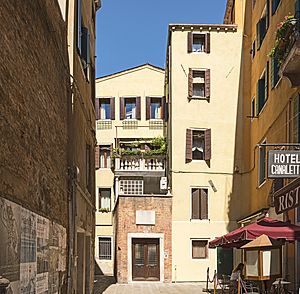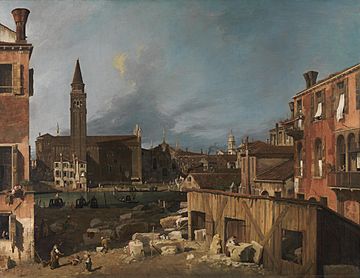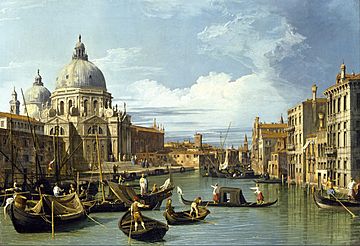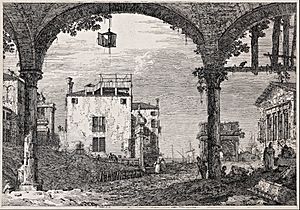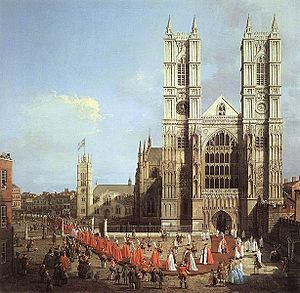Canaletto facts for kids
Quick facts for kids
Canaletto
|
|
|---|---|
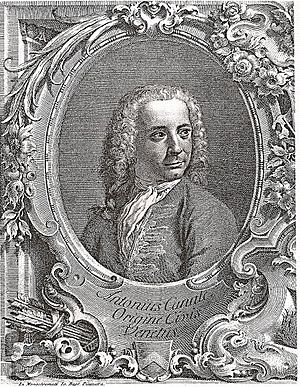 |
|
| Born |
Giovanni Antonio Canal
18 October 1697 |
| Died | 19 April 1768 (aged 70) Venice, Venetian Republic (now Italy)
|
| Nationality | Venetian |
| Education | Luca Carlevaris |
| Known for | Landscape art, etching |
|
Notable work
|
The Stonemason's Yard |
| Patron(s) | Owen Swiny Joseph Smith |
Giovanni Antonio Canal (born October 18, 1697 – died April 19, 1768) was a famous Italian painter. He is better known as Canaletto. He was an important artist from the 18th-century Venetian school of painting.
Canaletto was best known for his detailed paintings of cities. These are called vedute (say: veh-DOO-tay). He painted many scenes of Venice, Rome, and London. He also created imaginary scenes, known as capricci. Sometimes it's hard to tell if his paintings were real or imagined! He was also a skilled printmaker who used a technique called etching.
From 1746 to 1756, Canaletto lived and worked in England. There, he painted many views of London and other places. These included famous castles like Warwick Castle and Alnwick Castle. He became very popular in England. This was thanks to a British merchant named Joseph "Consul" Smith. Smith owned a large collection of Canaletto's art. In 1762, he sold this collection to King George III.
Contents
Canaletto's Early Life & Art Career
Giovanni Antonio Canal was born in Venice. His father, Bernardo Canal, was also a painter. This is why Giovanni was called Canaletto, which means "little Canal". He learned to paint from his father. They worked together on designing sets for plays and operas.
In 1718, Canaletto traveled to Rome with his father. They created scenery for two operas by Alessandro Scarlatti. While in Rome, Canaletto was inspired by another artist, Giovanni Paolo Pannini. Pannini painted city views. Canaletto then started painting the daily life of cities and their people.
After returning to Venice in 1719, Canaletto began painting in his unique style. His first known painting is Architectural Capriccio from 1723. He also studied with Luca Carlevarijs, who was a well-known painter of city scenes. Canaletto quickly became as good as his teacher.
In 1725, an art buyer named Alessandro Marchesini was looking for paintings of Venice. He was told to look at Antonio Canale's work. The agent said, "it is like Carlevaris, but you can see the sun shining in it." This shows how special Canaletto's paintings were.
Painting Outdoors & Accuracy
Many of Canaletto's early paintings were done "from nature." This means he painted them outdoors, looking at the actual scene. This was different from most artists at the time, who finished their paintings in a studio.
Canaletto's paintings are known for being very accurate. For example, he showed how Venice would flood with water and ice during different seasons. Experts used to think he might have used a special device called a camera obscura. This device projects an image onto a surface, which an artist could trace. It is known that Canaletto owned one. However, many experts now believe he used it more for inspiration than for tracing every detail.
Famous Early Works
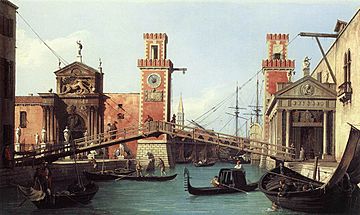
Canaletto's early paintings are often considered his best and are highly valued. One of his most famous early works is The Stonemason's Yard. It was painted around 1725 and shows a simple working area in Venice. This painting is seen as one of his finest pieces.
Later, Canaletto painted grand scenes of Venice's canals and the Doge's Palace. His large paintings showed the city's important events and old traditions. He was very good at showing light and color. Some people say his style helped lead to Impressionism, a later art movement.
Canaletto's Time in England
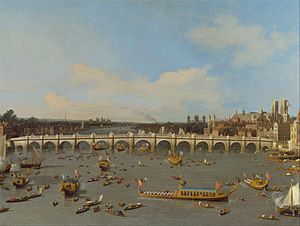

Many of Canaletto's paintings were sold to wealthy Englishmen. These men were often on their "Grand Tour" of Europe. At first, an agent named Owen Swiny helped sell his art. Later, a banker named Joseph Smith became his main supporter. Smith was appointed the British Consul in Venice in 1744. He bought almost 50 paintings, 150 drawings, and 15 etchings from Canaletto. This was the largest collection of Canaletto's work. Smith later sold it to King George III in 1763.
In the 1740s, fewer British visitors came to Venice because of a war. This made it harder for Canaletto to sell his art. So, in 1746, Canaletto moved to London to be closer to his customers.
While in England, Canaletto lived in London's Soho district. He stayed in England until 1755. During this time, he painted many views of London. These included several paintings of the new Westminster Bridge, which was finished while he was there. He also painted the homes and castles of his wealthy patrons.
Some people expected Canaletto to paint England exactly as he painted Venice. However, his work in England sometimes seemed less fresh and more repetitive. An art critic even suggested that the person painting as 'Canaletto' might be an impostor! This might have been because Canaletto's nephew, Bernardo Bellotto, also used the nickname. Or, it could have been spread by dishonest art dealers.
To prove he was the real Canaletto, the artist put an advertisement in a newspaper. He invited anyone to come see his latest painting at his studio. Even so, his reputation never fully recovered during his lifetime.
After returning to Venice, Canaletto was elected to the Venetian Academy in 1763. He continued to paint until he died in 1768. In his later years, he often used old sketches. But he still created surprising new paintings. He was also willing to change small details in his scenes to make them look better artistically.
Canaletto's Influence & Legacy
Canaletto had many students. These included his nephew Bernardo Bellotto, Francesco Guardi, and Michele Marieschi. Other artists, like Giuseppe Bernardino Bison, also followed his style.
Joseph Smith's large collection of Canaletto's art was sold to King George III. This collection now forms a big part of the Royal Collection in Britain. Many other British art collections also have Canaletto's works. For example, the Wallace Collection has 19 of his paintings. Woburn Abbey has a set of 24 paintings in its dining room.
Canaletto's city views have always been very valuable. Even in the 18th century, powerful rulers like Catherine the Great wanted his grandest paintings. The highest price ever paid for a Canaletto painting at an auction was £18.6 million. This was for View of the Grand Canal from Palazzo Balbi to the Rialto in 2005.
See also
 In Spanish: Canaletto para niños
In Spanish: Canaletto para niños
- List of works by Canaletto
- Bernardo Bellotto, also known as "Canaletto" in Germany and Poland, was Canaletto's nephew and pupil


